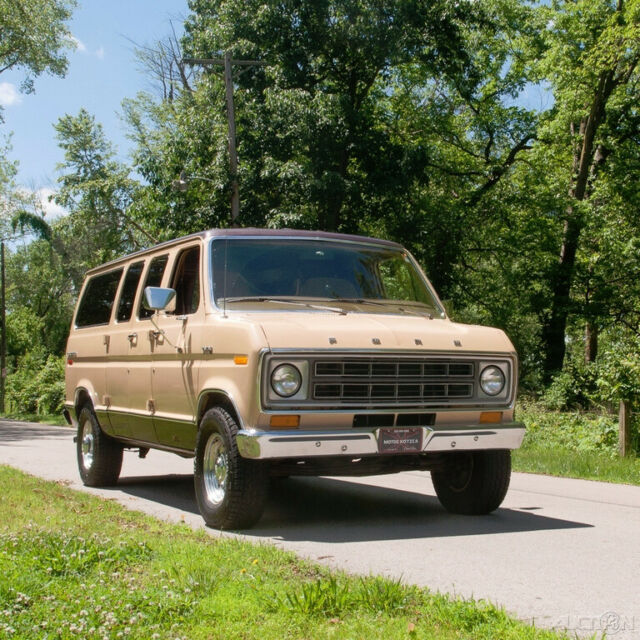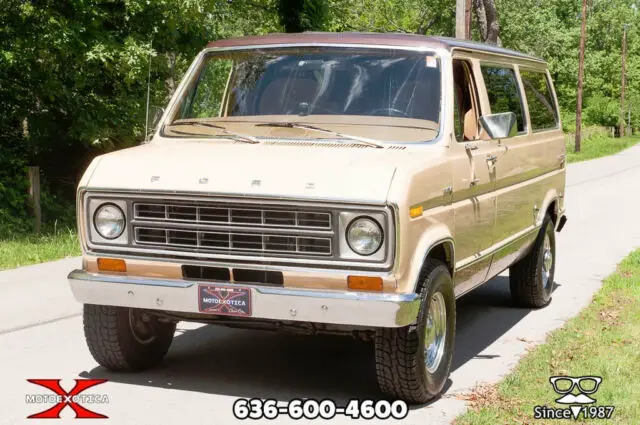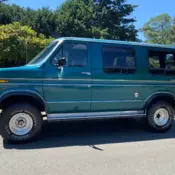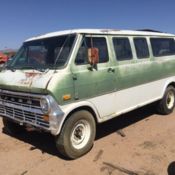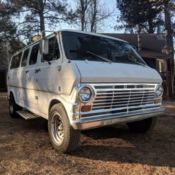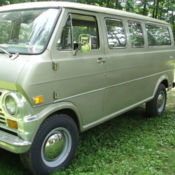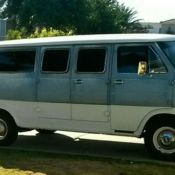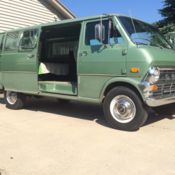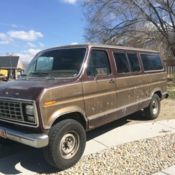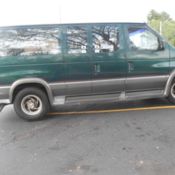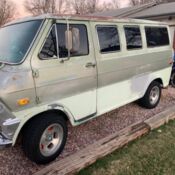1978 Ford Econoline 250 Club Wagon Chateau Van
1978 Ford Econoline 250 Van
1978 Ford Econoline 250 Club Wagon Chateau Van
Two owner survivor ¾-ton Ford Club Wagon Chateau vanSold new at Gary Sage Ford in Keokuk, original female owner had it until her passing in 2011Indio Tan exterior (code X) with Dark Brown Metallic trim (code H) and a tan and dark brown interior460 CID V-8 engine (VIN code A) previous owner stated that it was rebuilt about five thousand miles agoC6 Selectshift Cruise-O-Matic three-speed automatic transmission (code G) and 3.73 gearing (code 38)New brakes and suspensionAir-conditioning, power steering, power brakes and cruise controlFour captain's chairsDynamat sound dampingCorrugated metal interior trim with rear-mounted amplifier rack powered by its own battery138-inch wheelbase7,550 GVWRNeed room for your drum kit? Hoping to find something to carry you, your wife and two kids plus all of your mountain bikes to the nearest trails? Looking for a van to tow your new boat? MotoeXotica Classic Cars presents this 1978 Ford E-series 250 Van in top-of-the-line Chateau trim. This van is a true survivor and comes from Keokuk Iowa where it sold new at Gary Sage Ford in Keokuk, the original female owner had the van until her passing in 2011. The second owner also from Keokuk, purchased the survivor van and updated it with a professional stereo system, Dynamat interior and some mechanical restoration.
Built at Ford's Lorain, Ohio (VIN code H) factory on June 21, 1978, this van was destined for the Davenport, Iowa area (DSO code 56), where it was delivered to Gary Sage Ford Lincoln-Mercury in Keokuk, Iowa. The van had resided in the same city until 2019 with two local owners.
Finished in Indio Tan (code X) with Dark Brown Metallic trim (code H), this van's paint and trim are in overall very good order and looks classy in this combination. The van's body is straight and solid, the engine bay is tidy, the cargo area is excellent condition and the chrome bumpers look good. Back to the cargo bay, there is currently a single foam mattress aft of the four captain's chairs while the interior walls are capped with corrugated metal overlays. On the passenger side is a separate battery powering a Pioneer infotainment system.
This van rolls on Trazano SL369 tires, size LT265/75R16 at all four corners. Each tire is mounted on vented alloy wheels with Ford center caps. The wheels and tires are all in very good order.
Under the very short hood is Ford's 460 CID V-8 engine with loads of torque for towing and hauling. Previous owner stated that the engine was rebuilt at around 54,000 miles though we have no documentation to support that claim but the van does run very well. Backing this motor is Ford's three-speed automatic transmission and a 3.73:1 rear end. Driver convenience features include air-conditioning, power steering, power brakes and cruise control. Van also sports new brakes and suspension bits.
Inside, the van's tan, cloth seats look great, save for a very minor blemish on the lower seatback of the front passenger seat. The contrasting dark brown carpet is in similar condition while the brown headliner is good, original order. The factory, two-spoke steering wheel with its wood veneer, looks good, while the tan instrument panel (shared with the F150 pickups) and inner door liners are all in good, original shape. The front console and shift lever are in similar order. There's a Pioneer AM/FM stereo with CD and RDS receiver that accepts SD, Mini SD, Micro SD and SD HC cards. The van's floor has Dynamet applied, too. In the back, corrugated metal trim acts like wainscoting and there's a rear-mounted amplifier rack system powered by its own battery, minus subwoofers.
For 1975, the Econoline/Club Wagon were given a complete redesign. Based on an all-new chassis, Ford became the first American manufacturer to adapt body-on-frame construction to a full-size van.
The new-generation Econoline would become common not only in its own right, but as the basis for other vehicles. With a full frame, the Econoline became popular as a cutaway van chassis; the design served as a basis for many ambulances, and various types of trucks and buses. The shared drivetrain with the F series marked the beginning of aftermarket four-wheel drive conversions. During the 1970s, the Econoline became popular as a basis for van conversions. Using the sparsely-equipped Econoline cargo van as a basis, a luxurious interior was fitted, along with extensive customization of the exterior.
To increase the versatility of the full-size van line, the Econoline was developed using body-on-frame construction for the first time. In addition to increasing the strength of the chassis, the configuration allowed more commonality with the F-series trucks. As before, the Twin I-Beam front suspension was used. In its new configuration, the engine was moved further forward and lowered, relative to the body. In a massive growth spurt, the short-wheelbase configuration was 0.5 inches longer than the previous long-wheelbase chassis; the new long-wheelbase chassis was 138 inches, the longest wheelbase full-size van sold until 1990.
Unlike its predecessors, Ford designed the 1975 Econoline with a true "two-box" layout. Similar to the Ford Transit of the time, the configuration moved the engine as far forward as possible and lower in the chassis than in its predecessor; although the hood was nearly twice as long, the hoodline was much lower. A higher degree of parts commonality with the F series made itself known in the body styling: the vent windows, taillights, bumpers, and wheels were common items between the two vehicles.
During its sixteen-year production run, the exterior of the Econoline/Club Wagon would remain nearly unaltered. In 1978, the Super Van/Super Wagon was introduced; based on the 138-inch wheelbase, it was a rear body extension allowing for extra cargo room or an extra row of seating (for up to 15 passengers).
Inside, the redesign of the chassis expanded interior room, though the rear of the engine still remained between the front seats; an engine cover still provided access for servicing. Sharing many controls with the F series, the new design also improved interior ergonomics. In three body sizes, the Econoline was produced in a cargo van and passenger van, with the latter produced in three trim levels; base, Custom and Chateau.
Competition to this E250 included Chevrolet's G20, Dodge's B-series, GMC's G20 and Volkswagen's Bus.
If you're a Ford truck collector, if you're looking for something rugged to haul and/or tow, you owe it to yourself to stop by MotoeXotica Classic Cars to check out this survivor Ford E250.
VIN: E25AHCF3270
This van is currently located at our facility in St. Louis, Missouri. Current mileage on the odometer shows 59,374 miles. It is sold as is, where is, on a clean and clear, mileage exempt title. GET OUT AND DRIVE!!!
Note: Please see full terms and conditions listed below that pertain to the purchase of any said vehicle, thank you.
- Make: Ford
- Model: Econoline 250
- SubModel: Econoline 250 Club Wagon Chateau Van
- Type: Minivan/Van
- Trim: Van
- Year: 1978
- Mileage: 59374
- VIN: E25AHCF3270
- Color: Brown
- Engine size: 460 CID V-8
- Number of cylinders: 8
- Transmission: Automatic
- Interior color: Brown
- Vehicle Title: Clear Want to buy? Contact seller!
